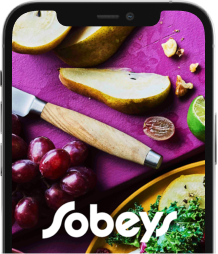Beef, especially if it’s a premium cut, is a bit of a splurge, so cooking steak can seem a little daunting. But have no fear! Follow our three steps, and you’ll be serving up tender, juicy steaks like a pro, whether you’re firing up the grill or using a hot skillet on the stovetop.
Step 1: Pick It
Premium cuts, such as tenderloin, strip loin, T-bone and rib-eye, come from the loin and rib sections. They are naturally tender and great whether grilled or pan-fried. Some are boneless, while others are bone-in — just choose whichever you like better. For some people, gnawing on the bone is the best part, because the meat attached to it is extra flavourful.
Less-premium cuts are sometimes called marinating steaks. They aren’t as naturally tender, but they are super tasty and affordable. As their name implies, they’re great for marinating. Try simply grilling and slicing flank steak against the grain, or roll it around a tasty filling, as in Spinach & Chaumes Cheese Stuffed Flank Steak. Marinate blade and sirloin tips before grilling or pan-frying them, or marinate, grill and slice skirt steaks for a backyard taco party.
For a special steak dinner, play it safe and buy 8 oz (250 g) of raw boneless beef or 12 oz (375 g) of raw bone-in meat per person. Steaks shrink a little during cooking, plus you’ll have tasty leftovers for sandwiches. Tip: If you’re cooking for a crowd and grill space is at a premium, buy thick steaks and slice them before serving.
Step 2: Prep It
It takes just a few steps to get steaks ready to cook. Here’s what you need to do, as well as some myths we’re happy to bust.
- Trimming: Most steaks come trimmed and ready to cook. However, cuts such as strip loins and rib-eyes can have a generous fat cap, which can cause flare-ups on the grill. Use a sharp knife to trim it down to around 1/4 inch (0.5 cm) thick. But don’t cut all that fat off — it keeps the meat juicy as it cooks.
- Seasoning: When it comes to steak, the single most important seasoning is salt — yes, salt! — as it brings out the lip-smacking flavour of beef. For even distribution, use a fine-grain table or sea salt, or a medium-grain kosher salt. (Save the fancy coarse sea salt for sprinkling over sliced thick steaks just before serving.) You have two choices on timing: the first is to salt the meat immediately before cooking; the second is to add salt at least one hour or up to 24 hours prior to grilling or pan-frying. Salting steaks draws out moisture, but if it’s done an hour or more ahead of cooking, the meat will have time to reabsorb that beefy brine. In either case, use a paper towel to dry off any moisture on the surface immediately prior to cooking. Purists stick to just sea salt and freshly ground pepper for seasoning, but we also love this Spice-Crusted Steak with Herb & Garlic Potatoes.
- Marinating: Acidic ingredients, such as lemon juice and vinegar, have some tenderizing effect on steak, but marinades are mostly for adding flavour. They are generally best for less-expensive cuts, such as flank and sirloin tip, which can stand up to bold tastes. Try a simple Classic Marinated & Grilled Steak, or enjoy the fresh flavours of sage, rosemary and basil in Herb-Marinated Flank Steak.
- Tempering and Drying: Many aficionados let their steaks come up to room temperature before cooking, but you don’t need to. This step (called tempering) doesn’t make much of a difference in how the meat cooks. All steaks, however, should be as dry as possible to maximize browning; use a paper towel to blot surface moisture right before cooking.
Step 3: Cook It
To create a rich, brown crust and a juicy interior, cook steaks over high, dry heat. That means on the grill or in a heavy-duty frying pan, such as a cast-iron skillet, on the stovetop.
Option 1: Grill It
Whether you use charcoal or gas, it’s important to have two heat zones for grilling steaks. One should be hot enough to brown the meat but not so fiery that the exterior burns or dries out before the inside is done. The other should be cooler for finishing up thick steaks or moving pieces away from flare-ups, which can impart a bitter flavour. Generally, steaks less than 1 inch (2.5 cm) thick can be cooked completely in the hot zone, whereas thicker steaks can be browned in the hot zone and then moved to the cooler area to finish cooking.
Unless you want perfect grill marks, flip steaks regularly, as it helps the meat cook more quickly and evenly. It also prevents dry edges and stops the curling and cupping that can happen when the outer fat shrinks. Try it on a Grilled T-bone Steak with Lemon-Dill Butter & Asparagus tonight.
Option 2: Pan-Fry It
Pan-frying creates such a delicious, evenly brown crust that some cooks prefer to grilling. Make sure you use a skillet made of a heavy-duty material, such as cast iron, so it maintains the heat when you add the meat.
Heat an oven-proof pan over medium-high heat. (There’s a popular theory that you must sear over high heat to seal in juices, but this technique can lead to overcooked steaks if you’re still getting a feel for it.) Use a neutral oil with a high smoke point, such as vegetable or canola oil, and flip the steak often for best results. Sear cuts thicker than 1 inch (2.5 cm) on the stovetop and then transfer the pan to a 400°F (200°C) oven to finish cooking. For a quick pan-fried steak dinner, try One-Skillet Pepper Steak with Beans & Greens
Testing for Doneness
The only foolproof way to know if a steak is done is to check its internal temperature. Health Canada’s Safe Internal Cooking Temperatures Chart recommends 63°C (145°F) for medium-rare, 71°C (160°F) for medium and 77°C (170°F) for well-done. Here are a few tips to follow when checking to see if your steak has reached the necessary safe internal cooking temperature.
- Remove the steak from the heat and insert a digital instant-read thermometer horizontally into the thickest part of the meat, making sure the tip reaches all the way to the middle.
- Make sure the thermometer is not touching any bones, because they heat up more quickly than the meat and could give you a false reading.
- If you are cooking more than one steak, be sure to check each piece separately, as temperatures may differ among them.
Juiciness-Boosting Tip:
Let cooked steaks rest for 5 to 10 minutes. The juices will redistribute and end up in your mouth — not on the plate — when you cut into the meat.






